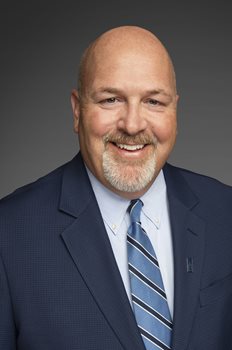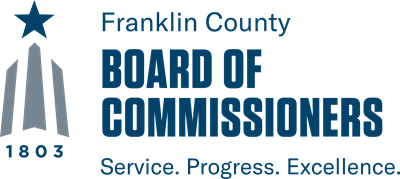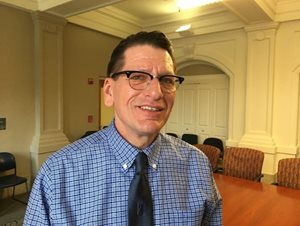A LETTER FROM JOHN O'GRADY, FRANKLIN COUNTY COMMISSIONER
Hello and welcome to the April edition of the Commissioner Connection newsletter.
This is my favorite time of year, and it finally feels like spring is

here. This month is also National County Government Month, so it’s a great time to share some of what we commissioners and our fellow elected county leaders are up to.
In this edition of the newsletter, you’ll find a guest column from our county engineer, Cornell Robertson about the innovative new Transportation Improvement District that we just approved, as well as a profile of a county employee who has overcome some serious health challenges and recently been recognized statewide for his great service. You’ll also learn about a great community partner that we work with each year. Other accomplishments that I’m proud of already this year include the new ability to
text to 911 in an emergency, our new
Forward Cities partnership to support entrepreneurs in struggling neighborhoods, and an
award we won for being a healthy workplace.
Perhaps most exciting this month is the annual
State of the County Report. Once again this year, the report shows that the state of our county is strong, and highlights a lot of the service your county government provides for every Franklin County resident every day. We know that our 14 county agencies provide service directly to hundreds of thousands of Central Ohioans, and I believe that there isn’t anyone in Franklin County whose life isn’t affected in some way each year by county government.
Another exciting and important thing going on this April is that we are one year out from the beginning of the decennial census that is required by the U.S. Constitution. It is more important than ever to ensure that every county resident is counted this year. Census data determine how many representatives Ohio has in Congress, so we must be sure to count all of Franklin County’s growing population to help make up for shrinking numbers elsewhere in Ohio. In addition, census data help direct more than $33 billion federal dollars to our state for things like road planning and construction, Medicaid and Medicare, school lunches and nutrition programs, low-income housing, Head Start, WIC, and other vital services. For more information about the census, visit
Columbus.gov/ColumbusCounts.
Thank you again for taking the time to read our quarterly newsletter and learn about how your county government is serving you and your neighbors. Please reach out to my office via the
Board of Commissioners website if you have any questions or concerns, and keep up with everything the commissioners are up to by following the board on
Facebook and
Twitter as we continue working to make Franklin County a great place to build a business or raise a family.

John O'Grady
Franklin County Commissioner
2019 STATE OF THE COUNTY REPORT

Each year, the Board of Commissioners issues an annual State of the County Report to update residents on the health and progress of Franklin County. This year, once again, the commissioners are pleased to be able to report that the state of the county is strong. To see the full report,
visit
report.franklincountyohio.gov/.
SPOTLIGHT ON A COUNTY EMPLOYEE—BRUCE TOLBERT

Statewide, the Department of Job and Family Services operates Ohio’s Adult Protective Services program, which helps adults over 60 who may be in danger of harm, are unable to protect themselves, and who may have no one else to assist them. In Franklin County, if you worry that a senior friend or family member may be in danger, being neglected, or could be being exploited, Franklin County’s Office on Aging is the agency to contact. For the past 20 years, one of the Office on Aging team members who investigates cases like this has been Bruce Tolbert.
Thanks for taking the time to tell us a little about yourself and your role. Help us first to understand what Adult Protective Services is and what it does, and how you guys get involved in a case.
Every county in Ohio has an APS program that investigates reports that a senior citizen might not being getting the care that they deserve, whether because of abuse, neglect, or exploitation. Some older people will call us themselves, but usually we hear from a relative or concerned neighbor, someone like that. We’ve had an uptick in reports from bank tellers lately because state law now makes them mandatory reporters like a doctor, police officer, or emergency medical services. We also get some false reports due to family feuding or just honest mistakes. We’d always rather somebody give us a call and let us investigate than to not say anything if they have a concern. There's a hotline, and reporters can remain anonymous.
What’s a typical investigation like, and how many have you done?
In my 20 years, I’ve been part of more than 2,000 investigations. We start with an unannounced visit, and the senior citizen becomes our client. We work entirely in their best interest and for free. We’re not there to send them to a nursing home or anything like that, just to make sure that they’re in a safe, caring environment with people who are looking out for them. It can take up to a month or more, but happens much, much faster in emergency cases, and the client retains the right to make decisions on their own behalf. We also keep everything confidential.
That sounds really rewarding, but also like it could be really tough sometimes.
It is, both. You get to see the really good and really bad side of people, but you also get to help out, which makes up for a lot of the tough stuff. I was held hostage once at gunpoint for several hours though, by a client with dementia. Fortunately, the sheriff was able to deescalate things, and we got him to an appropriate facility. Other times, we need to be careful of potential perpetrators who may not want us to investigate a particular case, so we always work in pairs especially on new cases.
Wow. Hopefully your typical day isn’t that exciting.
No, typically it’s not. I’m an early bird, so I’m usually in by 6:30 or so to get started on emails and reports—we document absolutely everything. Then in the early afternoon, we typically head out into the field. There’s lots of door knocking and leaving messages. We work hard to meet our clients where they are, both physically and emotionally, so we spend a lot of time getting to know them, building rapport, and making them comfortable.
Tell us a little about yourself and how you came to be in this job.
My family moved around a lot when I was young, but Greenfield, Ohio feels like home. I got a degree in Psychology from the University of Findlay, then went to work with developmentally mentally ill patients in Akron and got a degree in Social Work at the University of Akron. In 2004, I received a master’s degree in Criminal Justice Administration from Tiffin University. I’ve been in APS since 1999, and I married my husband, Dave, last year in the midst of a health scare—just a couple months out of chemo. We’ve got three great dogs.
That’s right, I understand that you’ve faced some significant health challenges lately.
Yes. Things happen when you least expect them. I had a small seizure while visiting a client in August of 2017, then two bigger ones later that day. Eventually, I was diagnosed with brain cancer. After more than a year, through four surgeries and other fantastic care at OSU Medical Center, and even a piece of custom polymer prosthetic skull, I was able to return to work last spring.
This year, you were named statewide APS worker of the year. That’s quite an honor. What qualities make somebody good at your job?
Yes. It’s a huge honor. To be good at a job like this, you’ve got to be caring and empathetic, a good listener, able to weed out good info from bad, and to connect with clients, and you’ve got to be tough. I’m sure I’m better at all of that than I was before I got sick.
What do you wish more people knew about the county’s Office on Aging or Adult Protective Services?
Not enough people know about APS in the first place—they know about Children Services, but not us. We do lots of outreach and training, but we don’t have a magic wand. I want every senior to know that we’re here for them, that we’re on their side, and that we will work to empower them to make the best decisions for themselves.
To learn more about the Office on Aging or how to make a report to Adult Protective Services, visit
officeonaging.org. To report a suspected case of elder abuse, neglect, or exploitation, call 614-525-4348.
INNOVATION DRIVES TRANSPORTATION IMPROVEMENT IN FRANKLIN COUNTY
Guest Column
by Cornell Robertson
Franklin County Engineer
 The Franklin County Engineer’s Office is an agency of action, innovation, and collaboration. As your county engineer, I strive to lead an office that provides for the safe and efficient movement of people and goods from place to place by building and maintaining Franklin County’s roads and bridges.
The Franklin County Engineer’s Office is an agency of action, innovation, and collaboration. As your county engineer, I strive to lead an office that provides for the safe and efficient movement of people and goods from place to place by building and maintaining Franklin County’s roads and bridges.
We are on the verge of a change to public transportation that could be as dramatic as the change from horses to automobiles. Technology and innovations in roadway infrastructure, ride-share services, and connected and autonomous vehicles, as well as, public transit, rail, and air are evolving at a rapid pace. The transportation industry should embrace these innovations. There will be opportunities to increase capacity and increase safety of transportation, but it will take work and participation by all.
Innovation comes in all shapes and sizes. The recent creation of the Franklin County Transportation Improvement District (FCTID) is a microcosm of the innovation that the engineer’s office represents. A TID promotes intergovernmental and public-private partnerships to optimize transportation resources and leverage additional transportation investments. The cities and townships within Franklin County have, historically, worked very well together. However, formalizing such collaboration through the establishment of a TID will allow us to apply for additional funding that is currently out of our reach and will make us more competitive for grants to improve corridors such as: Alum Creek Drive from Rickenbacker to
I-270, Ferris Road from Karl Road to Westerville Road, and Cooke Road from I-71 to Cleveland Avenue.
On March 12, 2019, the Franklin County Board of Commissioners approved the creation of the FCTID. President Brown, Commissioner O’Grady, and Commissioner Boyce also appointed the five member board. The voting members include myself, Erik Janas (Deputy County Administrator for the Franklin County Commissioners), Alex Beres (Assistant Director at Franklin County Economic Development and Planning), Robert Priestas (City of Gahanna Director of Public Service & Engineering), and Zach Woodruff (City of Whitehall Director of Economic Development & Service). The inaugural meeting of the FCTID was held on April 9, and future meetings are scheduled to be held on the fourth Thursday of each month. The FCTID plans to submit an application for funding to the Ohio Department of Transportation’s Office of Jobs & Commerce by the end of May 2019.
The revenue streams to maintain roadway  and bridge infrastructure are decreasing while construction costs continue to increase. Funding grants continue to become more and more competitive and more difficult to procure. Consequently,
and bridge infrastructure are decreasing while construction costs continue to increase. Funding grants continue to become more and more competitive and more difficult to procure. Consequently,
a funding pothole has formed.
As the Franklin County Engineer and a conscious steward of taxpayers’ dollars,
I will utilize all of the tools that have been made available to me to most efficiently fund the maintenance of ou roads and bridges such as TIDs. Furthermore, the Franklin County Engineer’s Office will continue to seek ways to improve our operations, for ways to cut costs, and for new maintenance methods to extend the useful life of our roads and bridges.
MEET A COUNTY PARTNER; OSU EXTENSION SHARES EXPERTISE WITH BUCKEYES THROUGHOUT THE STATE
 Ohio State University Extension helps to fulfill the mission and promise
Ohio State University Extension helps to fulfill the mission and promise
of a public, land-grant college by bringing knowledge and expertise directly to Ohioans throughout the state. All 88 of Ohio’s counties have an Extension office dedicated to working with people to strengthen their own communities, engaging residents and creating opportunities for them to access and use science-based knowledge and resources.
For instance, Extension works with 4-H to help develop leadership skills
in young people, and engages older Ohioans with agricultural and, gardening resources to foster lifelong learning. Extension can also provide services such
as soil testing and livestock consultation for farmers.
Extension offices are part of the university, but they aren’t funded by the university. Instead, they receive most of their funding directly from the state, and from the county in which the office is located. They also receive some federal and grant monies. This year, the Franklin County office of OSU Extension will receive a community partner grant from the Board of Commissioners in the amount of $175,000 to serve more than 40,000 county residents in
areas of financial education and life skills training, agricultural yield assistance, environmentally sensitive growing practices, health and wellness, family and consumer sciences, and 4-H youth development.
 The Franklin County office of OSU Extension is also excited to have broken ground recently on a new facility at the Waterman Agricultural and Natural Resources Laboratory. The 10,500-square-foot facility is made possible by a private donation that will also support two endowed 4-H educator positions and an endowed Franklin County support fund.
The Franklin County office of OSU Extension is also excited to have broken ground recently on a new facility at the Waterman Agricultural and Natural Resources Laboratory. The 10,500-square-foot facility is made possible by a private donation that will also support two endowed 4-H educator positions and an endowed Franklin County support fund.
For more information about OSU Extension, visit extension.osu.edu/home.
For more information about Franklin County’s Community Partner Grants, visit budget.franklincountyohio.gov/grants/community-partnership-program
MAKE SURE YOUR FAMILY IS COUNTED IN THE 2020 CENSUS

Each year, Washington allocates more than $2,800 in federal spending per person in Ohio based on data from the decennial census, and the next count is just a year away. The 2020 census will guide policy for a decade, so it is more important than ever to make sure that every resident in our community is accurately counted.
The census provides detailed data that directs more than
$33.5 billion to Ohio communities.
Programs like:
| Medicaid |
SNAP |
Medicare Part B |
Section 8 |
| Highway planning & construction |
Special Education |
School lunches |
Head Start |
| WIC |
|
|
|
City and county planners depend on accurate data to help build important services like schools, roads, and emergency services infrastructure. They also use it for economic development forecasts and neighborhood planning, and businesses use it to plan ahead for expansion and allocation of resources.
Census data also determine the number of representatives Ohio has in Congress, and we’re likely to lose another seat this time. So, with the population shrinking in some parts of Ohio, it’s particularly important that we make sure that Franklin County’s growing population is reflected in the count.
For more information, visit
Columbus.gov/ColumbusCounts.
NEIGHBORHOOD DEVELOPMENT IN WESTLAND
The commissioners’ Economic Development and Planning department is developing a strategic

plan for economic development in the Westland area. Kicking off the effort is an area-wide community meeting on April 29
th to solicit feedback on key topics such as redevelopment opportunities, mobility, zoning, planning, infrastructure, and inclusive growth.
All are welcome for this family-friendly event, and refreshments will be provided. A brief presentation will begin at 6:00 p.m., to be followed by group and individual activities to gain insight and feedback from the community.
April 29th at 6:00 p.m.
Haydocy Automotive
3895 West Broad St.
Columbus, Ohio 43228
For more information, call Jamie Edwards at 614-525-5361